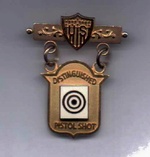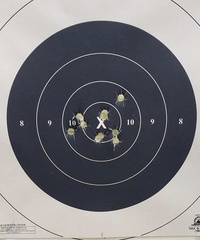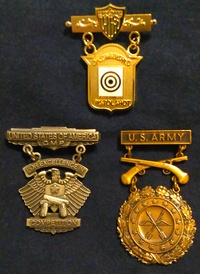Primer Hardness
+8
Multiracer
gregbenner
Tim:H11
zanemoseley
desben
cdrt
Chris Miceli
wheelsthatgrip
12 posters
Page 1 of 1
 Primer Hardness
Primer Hardness
I have always used Federal Small Pistol primers in my DR rounds; I have been to told by many they are the softest and mitigate light hammer hits. I have not been able to find any in over a year. So my quest is now for the next softest primer.
I found this link on another forum where a member used a Lee Hardness tester to measure the hardness of different primers:
http://www.theopenrange.net/forum/index.php?topic=8075.0;highlight=primer+hardness
What has been your experience? Which primers do you use in DR?
Keith
I found this link on another forum where a member used a Lee Hardness tester to measure the hardness of different primers:
http://www.theopenrange.net/forum/index.php?topic=8075.0;highlight=primer+hardness
What has been your experience? Which primers do you use in DR?
Keith
wheelsthatgrip- Posts : 21
Join date : 2013-08-21
 Re: Primer Hardness
Re: Primer Hardness
If your DR pistol is in compliance with the rulebook i don't think you'll have a need for searching out the softest primers. I always use Federal or Winchester though.
Last edited by Chris Miceli on 4/11/2018, 7:41 am; edited 1 time in total
Chris Miceli- Posts : 2715
Join date : 2015-10-27
Location : Northern Virginia
 Re: Primer Hardness
Re: Primer Hardness
Winchester, Tula, CCI; they all work the same. If you have light strikes, it's a gun problem, not a primer problem.

cdrt- Posts : 844
Join date : 2016-04-12
Location : Amarillo, Texas
 Re: Primer Hardness
Re: Primer Hardness
FWIW, in my revolver (S&W mod 14), CCI sometimes won't fire in double action, but S&B will. In single action, anything works.

desben- Posts : 385
Join date : 2013-12-22
Location : Ontario, Canada
 Re: Primer Hardness
Re: Primer Hardness
I've heard many revolver people don't like anything but Winchester for double action, they despise CCI. I love CCI for my 1911.
zanemoseley- Posts : 2688
Join date : 2015-07-11
Location : Cookeville, TN
 Re: Primer Hardness
Re: Primer Hardness
desben wrote:FWIW, in my revolver (S&W mod 14), CCI sometimes won't fire in double action, but S&B will. In single action, anything works.
Sounds like a weak hammer spring. Is your hammer spring tension screw tight?

Tim:H11- Posts : 2133
Join date : 2015-11-04
Age : 36
Location : Midland, GA
 Re: Primer Hardness
Re: Primer Hardness
Tim, it's screwed on tight, and it's the factory hammer spring. But maybe it's getting a bit tired; I must have put around 8k rounds on it, plus however many by the previous owner(s). Is this something you're supposed to replace once in a while?

desben- Posts : 385
Join date : 2013-12-22
Location : Ontario, Canada
 Re: Primer Hardness
Re: Primer Hardness
My Revolver is "in compliance with the rule book" and does not have a "gun problem"
It occasionally suffers light strikes due to way it is fired in sustained fire; cocking with the thumb and pulling the trigger. Sometimes, my thumb will lightly brush the hammer on it's way down. Having a softer primer is a help in this situation.
Keith
It occasionally suffers light strikes due to way it is fired in sustained fire; cocking with the thumb and pulling the trigger. Sometimes, my thumb will lightly brush the hammer on it's way down. Having a softer primer is a help in this situation.
Keith
wheelsthatgrip- Posts : 21
Join date : 2013-08-21
 Re: Primer Hardness
Re: Primer Hardness
desben wrote:Tim, it's screwed on tight, and it's the factory hammer spring. But maybe it's getting a bit tired; I must have put around 8k rounds on it, plus however many by the previous owner(s). Is this something you're supposed to replace once in a while?
I don’t know... could try a new one. All I know is it should bust em no matter the primer.

Tim:H11- Posts : 2133
Join date : 2015-11-04
Age : 36
Location : Midland, GA
 Re: Primer Hardness
Re: Primer Hardness
I shoot double action only, other than 1st shot. I have 3 CF revolvers all with lightened trigger pulls. With single action they will fire most any primer, in double action they will only fire reliably with Federal. I had no luck with Winchester, YMMV. I have occasionally use magnum primers if the only ones available. I load light, and have never had any issues.
gregbenner- Posts : 738
Join date : 2016-10-29
Location : San Diego area
 Re: Primer Hardness
Re: Primer Hardness
Remington is the next soft after Federal.
Multiracer- Posts : 998
Join date : 2017-03-15
Location : North Ohio
 Re: Primer Hardness
Re: Primer Hardness
What I've heard is that Federal primers are not necessarily a softer metal, but they are the only one that still use the old lead styphnate compound which is more sensitive and goes off easier than the new compound. If the primer is just plain brass and not nickel plated, it will be a softer metal. Winchester and S&B are plain brass primer cups and I've never had one fail to go bang.

oldsalt444- Posts : 288
Join date : 2011-10-26
Location : Commiefornia
 Re: Primer Hardness
Re: Primer Hardness
So you want a soft primer when you know you have technique issue causing these light strikes? Try a new spring, could be an instant cure to light strikes.wheelsthatgrip wrote:My Revolver is "in compliance with the rule book" and does not have a "gun problem"
It occasionally suffers light strikes due to way it is fired in sustained fire; cocking with the thumb and pulling the trigger. Sometimes, my thumb will lightly brush the hammer on it's way down. Having a softer primer is a help in this situation.
Keith
Last edited by Chris Miceli on 4/11/2018, 8:31 pm; edited 1 time in total
Chris Miceli- Posts : 2715
Join date : 2015-10-27
Location : Northern Virginia
 Re: Primer Hardness
Re: Primer Hardness
Light strikes in DA only are not usually a primer issue unless you do not seat them deep enough.
Modern primers will go bang with no major issue and when you get good strikes in SA and poor ones in DA, then it is likely you have improper tuning and poor spring setups in the gun.
In a Jerry Miculek video, he emphasized how lightly his gun was sprung, yet had no trouble with any primer because the pistol is set up correctly on the inside and primers are well set, so no energy is lost from the firing pin trying to set them deeper.
My 625 is set with a light and legal target trigger and I have given it a mild lockwork polishing and tuneup. I shoot CCI primers and have never had to hit one twice in SA or DA. Reducing the drag in the lockwork will go a looooong way towards solving your light strike issues.
Modern primers will go bang with no major issue and when you get good strikes in SA and poor ones in DA, then it is likely you have improper tuning and poor spring setups in the gun.
In a Jerry Miculek video, he emphasized how lightly his gun was sprung, yet had no trouble with any primer because the pistol is set up correctly on the inside and primers are well set, so no energy is lost from the firing pin trying to set them deeper.
My 625 is set with a light and legal target trigger and I have given it a mild lockwork polishing and tuneup. I shoot CCI primers and have never had to hit one twice in SA or DA. Reducing the drag in the lockwork will go a looooong way towards solving your light strike issues.

willnewton- Admin
- Posts : 1108
Join date : 2016-07-24
Location : NC
 Re: Primer Hardness
Re: Primer Hardness
Don't remember the source, this is from an article I read
?Different primers have different cup thicknesses. You can see the importance of cup thickness when primers are considered for semiautomatic rifles that have free-floating firing pins. This topic is discussed in greater detail in the post "MILSPEC PRIMERS FOR SEMI-AUTOS FAQ AND INFO" that follows the primer chart.
Handgun primers have thinner cups than rifle primers, making them easier to ignite with the typically weaker firing pin fall of handguns. Small Pistol primer cups are .017" thick, while Large Pistol primer cups are .020" thick. This is the reason using handgun primers in .22 Hornet rifle loads sometimes results in pierced primers in some guns. Obviously their substitution in the high pressure .223 Remington would not be a good idea.
Even the same type of primers from different manufacturers can have different cup thickness. Federal primers tend to have thinner cups than Winchester, Remington and CCI primers. On occasion this can be handy. Some revolver trigger and action lightening jobs may result in a lighter hammer fall that results in not all the primers going off. A switch to Federal pistol primers can make the load 100% again. The same thing can happen in cold weather with some “modern” bolt actions with light, fast firing pins. These are supposed to whack primers with the same approximate energy as an old-fashioned 98 Mauser strike, but under some adverse conditions they can occasionally use a little help. Federal primers can provide that help.
With Remington small rifle primers, the 6 ½ primer has a thin cup and is not recommended for higher pressure rounds like the common .223 Remington. It was intended for the .22 Hornet. When Remington introduced their .17 Remington round in 1971 they found that the 6 ½ primer was not suitable to the high-pressure .17. The 7 ½ BR primer was developed for this reason. According to Remington, the 7 ½ has a 25% greater cup thickness and they state on their web site: "In rifle cartridges, the 6-1/2 small rifle primer should not be used in the 17 Remington, 222 Remington or the 223 Remington. The 7-1/2 BR is the proper small rifle primer for these rounds."
CCI/Speer Technical Services says: "The CCI 400 primer does have a thinner cup bottom than CCI 450, #41 or BR4 primers... [with] the CCI #41 primer... there is more 'distance' between the tip of the anvil and the bottom of the cup." so that is their AR15 recommendation, although it seems like there are no complaints with using the BR4 and 450 primers by AR15 shooters and reloaders, in general. The #41 just gives you a little more safety margin for free-floating firing pins and would be the best choice for commercial reloaders who have no control over the rifles their .223 ammo is used in.
?Different primers have different cup thicknesses. You can see the importance of cup thickness when primers are considered for semiautomatic rifles that have free-floating firing pins. This topic is discussed in greater detail in the post "MILSPEC PRIMERS FOR SEMI-AUTOS FAQ AND INFO" that follows the primer chart.
Handgun primers have thinner cups than rifle primers, making them easier to ignite with the typically weaker firing pin fall of handguns. Small Pistol primer cups are .017" thick, while Large Pistol primer cups are .020" thick. This is the reason using handgun primers in .22 Hornet rifle loads sometimes results in pierced primers in some guns. Obviously their substitution in the high pressure .223 Remington would not be a good idea.
Even the same type of primers from different manufacturers can have different cup thickness. Federal primers tend to have thinner cups than Winchester, Remington and CCI primers. On occasion this can be handy. Some revolver trigger and action lightening jobs may result in a lighter hammer fall that results in not all the primers going off. A switch to Federal pistol primers can make the load 100% again. The same thing can happen in cold weather with some “modern” bolt actions with light, fast firing pins. These are supposed to whack primers with the same approximate energy as an old-fashioned 98 Mauser strike, but under some adverse conditions they can occasionally use a little help. Federal primers can provide that help.
With Remington small rifle primers, the 6 ½ primer has a thin cup and is not recommended for higher pressure rounds like the common .223 Remington. It was intended for the .22 Hornet. When Remington introduced their .17 Remington round in 1971 they found that the 6 ½ primer was not suitable to the high-pressure .17. The 7 ½ BR primer was developed for this reason. According to Remington, the 7 ½ has a 25% greater cup thickness and they state on their web site: "In rifle cartridges, the 6-1/2 small rifle primer should not be used in the 17 Remington, 222 Remington or the 223 Remington. The 7-1/2 BR is the proper small rifle primer for these rounds."
CCI/Speer Technical Services says: "The CCI 400 primer does have a thinner cup bottom than CCI 450, #41 or BR4 primers... [with] the CCI #41 primer... there is more 'distance' between the tip of the anvil and the bottom of the cup." so that is their AR15 recommendation, although it seems like there are no complaints with using the BR4 and 450 primers by AR15 shooters and reloaders, in general. The #41 just gives you a little more safety margin for free-floating firing pins and would be the best choice for commercial reloaders who have no control over the rifles their .223 ammo is used in.
gregbenner- Posts : 738
Join date : 2016-10-29
Location : San Diego area
 Re: Primer Hardness
Re: Primer Hardness
From what I understand, hardness is not the issue, it's a matter of sensitivity.
Here is one source of information on primers:
http://www.shootingtimes.com/ammo/ammunition_st_mamotaip_200909/
Here is one source of information on primers:
http://www.shootingtimes.com/ammo/ammunition_st_mamotaip_200909/
S148- Posts : 319
Join date : 2017-07-04
 Re: Primer Hardness
Re: Primer Hardness
I think Desben might have gave a clue also. I know a retired S&W gunsmith who used to shoot bullseye that said, you get a slightly less stronger hammer strike in double action compared to single action. The reason being the hammer doesn't get as long a drop, because the you pull the hammer back a little further when thumbing it back in single action.
Greg and Will are right on also, a great trigger set up is a lot more than just polishing the hammer notch and trigger sear surface. There are parts that need polishing and angles to adjust to each revolver. That double action should be as smooth as glass, then tuning of springs will bring it all together. This takes time and knowledge, which I would rather pay a good revolver smith to do.
Stan
Greg and Will are right on also, a great trigger set up is a lot more than just polishing the hammer notch and trigger sear surface. There are parts that need polishing and angles to adjust to each revolver. That double action should be as smooth as glass, then tuning of springs will bring it all together. This takes time and knowledge, which I would rather pay a good revolver smith to do.
Stan
chopper- Posts : 820
Join date : 2013-10-29
Age : 72
Location : Western Iowa
 Similar topics
Similar topics» Small Primer vs Large Primer 45 ACP Benchmark
» Odd CCI primer
» Primer question
» Primer Safety
» New primer manufacturing
» Odd CCI primer
» Primer question
» Primer Safety
» New primer manufacturing
Page 1 of 1
Permissions in this forum:
You cannot reply to topics in this forum